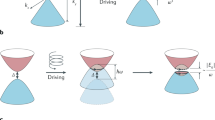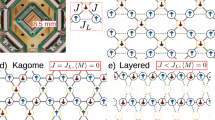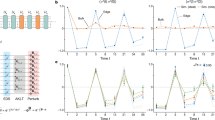Abstract
Robust edge states and non-Abelian excitations are the trademark of topological states of matter, with promising applications such as ‘topologically protected’ quantum memory and computing. So far, topological phases have been exclusively discussed in a Hamiltonian context. Here we show that such phases and the associated topological protection and phenomena also emerge in open quantum systems with engineered dissipation. The specific system studied here is a quantum wire of spinless atomic fermions in an optical lattice coupled to a bath. The key feature of the dissipative dynamics described by a Lindblad master equation is the existence of Majorana edge modes, representing a non-local decoherence-free subspace. The isolation of the edge states is enforced by a dissipative gap in the p-wave paired bulk of the wire. We describe dissipative non-Abelian braiding operations within the Majorana subspace, and illustrate the insensitivity to imperfections. Topological protection is granted by a non-trivial winding number of the system density matrix.
This is a preview of subscription content, access via your institution
Access options
Subscribe to this journal
Receive 12 print issues and online access
$209.00 per year
only $17.42 per issue
Buy this article
- Purchase on Springer Link
- Instant access to full article PDF
Prices may be subject to local taxes which are calculated during checkout





Similar content being viewed by others
References
Kane, C. L. & Mele, E. J. Z 2 topological order and the quantum spin Hall effect. Phys. Rev. Lett. 95, 146802 (2005).
Bernevig, B. A., Hughes, T. L. & Zhang, S-C. Quantum spin Hall effect and topological phase transition in HgTe quantum wells. Science 314, 1757–1761 (2006).
Koenig, M. et al. Quantum spin Hall insulator state in HgTe quantum wells. Science 318, 766–770 (2007).
Nayak, C., Simon, S. H., Stern, A., Freedman, M. & Sarma, S. D. Non-abelian anyons and topological quantum computation. Rev. Mod. Phys. 80, 1083–1159 (2008).
Fu, L. & Kane, C. L. Superconducting proximity effect and Majorana fermions at the surface of a topological insulator. Phys. Rev. Lett. 100, 096407 (2008).
Hasan, M. Z. & Kane, C. L. Colloquium: Topological insulators. Rev. Mod. Phys. 82, 3045–3067 (2010).
Kitaev, A. Y. Unpaired Majorana fermions in quantum wires. Phys. Usp. 44, 131–136 (2001).
Sau, J. D., Lutchyn, R. M., Tewari, S. & Sarma, S. D. Generic new platform for topological quantum computation using semiconductor heterostructures. Phys. Rev. Lett. 104, 040502 (2010).
Akhmerov, A. R., Nilsson, J. & Beenakker, C. W. J. Electrically detected interferometry of Majorana fermions in a topological insulator. Phys. Rev. Lett. 102, 216404 (2009).
Alicea, J., Oreg, Y., Refael, G., von Oppen, F. & Fisher, M. P. A. Non-abelian statistics and topological quantum information processing in 1D wire networks. Nature Phys. 7, 412–417 (2011).
Read, N. & Green, D. Paired states of fermions in two dimensions with breaking of parity and time-reversal symmetries and the fractional quantum Hall effect. Phys. Rev. B 61, 10267–10297 (2000).
Ivanov, D. A. Non-abelian statistics of half-quantum vortices in p-wave superconductors. Phys. Rev. Lett. 86, 268–271 (2001).
Lindner, N. H., Refael, G. & Galitski, V. Floquet topological insulator in semiconductor quantum wells. Nature Phys. 7, 490–495 (2011).
Kitagawa, T., Berg, E., Rudner, M. & Demler, E. Topological characterization of periodically driven quantum systems. Phys. Rev. B 82, 235114 (2010).
Weimer, H., Müller, M., Lesanovsky, I., Zoller, P. & Büchler, H. P. A Rydberg quantum simulator. Nature Phys. 6, 382–388 (2010).
Barreiro, J. T. et al. An open-system quantum simulator with trapped ions. Nature 470, 486–491 (2011).
Zhang, C., Scarola, V. W., Tewari, S. & Sarma, S. D. Anyonic braiding in optical lattices. Proc. Natl Acad. Sci. USA 104, 18415–18420 (2007).
Stanescu, T. D., Galitski, V., Vaishnav, J. Y., Clark, C. W. & Sarma, S. D. Topological insulators and metals in atomic optical lattices. Phys. Rev. A 79, 053639 (2009).
Goldman, N. et al. Realistic time-reversal invariant topological insulators with neutral atoms. Phys. Rev. Lett. 105, 255302 (2010).
Bermudez, A., Goldman, N., Kubasiak, A., Lewenstein, M. & Martin-Delgado, M. A. Topological phase transitions in the non-Abelian honeycomb lattice. New J. Phys. 12, 033041 (2010).
Jiang, L. et al. Majorana fermions in equilibrium and driven cold atom quantum wires. Phys. Rev. Lett. 106, 220402 (2011).
Diehl, S. et al. Quantum states and phases in driven open quantum systems with cold atoms. Nature Phys. 4, 878–883 (2008).
Kraus, B. et al. Preparation of entangled states by quantum Markov processes. Phys. Rev. A 78, 042307 (2008).
Verstraete, F., Wolf, M. M. & Cirac, J. I. Quantum computation, quantum state engineering, and quantum phase transitions driven by dissipation. Nature Phys. 5, 633–636 (2009).
Diehl, S., Yi, W., Daley, A. J. & Zoller, P. Dissipation-induced d-wave pairing of fermionic atoms in an optical lattice. Phys. Rev. Lett. 105, 227001 (2010).
Eisert, J. & Prosen, T. Noise-driven quantum criticality. Preprint at http://arxiv.org/abs/1012.5013 (2010).
Prosen, T. Third quantization: A general method to solve master equations for quadratic open Fermi systems. New J. Phys. 10, 043026 (2008).
Prosen, T. Spectral theorem for the Lindblad equation for quadratic open fermionic systems. J. Stat. Mech. P07020 (2010).
Lidar, D. A., Chuang, I. L. & Whaley, K. B. Decoherence free subspaces for quantum computation. Phys. Rev. Lett. 81, 2594–2597 (1998).
Berry, M. V. Quantal phase factors accompanying adiabatic changes. Proc. R. Soc. A 392, 45–57 (1984).
Simon, B. Holonomy, the quantum adiabatic theorem, and Berry’s phase. Phys. Rev. Lett. 51, 2167–2170 (1983).
Wilczek, F. & Zee, A. Appearance of gauge structure in simple dynamical systems. Phys. Rev. Lett. 52, 2111–2114 (1984).
Pachos, J., Zanardi, P. & Rasetti, M. Non-abelian Berry connections for quantum computation. Phys. Rev. A 61, 010305 (1999).
Carollo, A., Fuentes-Guridi, I., Franca Santos, M. & Vedral, V. Geometric phase in open systems. Phys. Rev. Lett. 90, 160402 (2003).
Beige, A., Braun, D., Tregenna, B. & Knight, P. L. Quantum computing using dissipation to remain in a decoherence-free subspace. Phys. Rev. Lett. 85, 1762–1765 (2000).
Bravyi, S. Universal quantum computation with the ν=5/2 fractional quantum Hall state. Phys. Rev. B 73, 042313 (2006).
Freedman, M., Nayak, C. & Walker, K. Towards universal topological quantum computation in the ν=5/2 fractional quantum Hall state. Phys. Rev. B 73, 245307 (2006).
Altland, A. & Zirnbauer, M. R. Nonstandard symmetry classes in mesoscopic normal–superconducting hybrid structures. Phys. Rev. B 55, 1142–1161 (1997).
Ryu, S., Schnyder, A., Furusaki, A. & Ludwig, A. W. W. Topological insulators and superconductors: Ten-fold way and dimensional hierarchy. New J. Phys. 12, 065010 (2010).
Rudner, M. S. & Levitov, L. S. Topological transition in a non-Hermitian quantum walk. Phys. Rev. Lett. 102, 065703 (2009).
Diehl, S., Tomadin, A., Micheli, A., Fazio, R. & Zoller, P. Dynamical phase transitions and instabilities in open atomic many-body systems. Phys. Rev. Lett. 105, 015702 (2010).
Gurarie, V. Single-particle Green’s functions and interacting topological insulators. Phys. Rev. B 83, 085426 (2011).
Bakr, W. S., Gillen, J. I., Peng, A., Foelling, S. & Greiner, M. A quantum gas microscope for detecting single atoms in a Hubbard regime optical lattice. Nature 462, 74–77 (2009).
Bakr, W. S. et al. Probing the superfluid-to-Mott insulator transition at the single-atom level. Science 329, 547–550 (2010).
Sherson, J. F. et al. Single-atom resolved fluorescence imaging of an atomic Mott insulator. Nature 467, 68–72 (2010).
Weitenberg, C. et al. Single-spin addressing in an atomic Mott insulator. Nature 471, 319–324 (2011).
Acknowledgements
We thank C. Bardyn, V. Gurarie, A. Imamoglu, C. Kraus and M. Troyer for helpful discussions. We acknowledge support by the Austrian Science Fund (FOQUS), the European Commission (AQUTE, NAMEQUAM), the Institut für Quanteninformation GmbH and a grant from the US Army Research Office with funding from the Defense Advanced Research Projects Agency OLE program.
Author information
Authors and Affiliations
Contributions
All authors have contributed equally.
Corresponding author
Ethics declarations
Competing interests
The authors declare no competing financial interests.
Supplementary information
Supplementary Information
Supplementary Information (PDF 485 kb)
Rights and permissions
About this article
Cite this article
Diehl, S., Rico, E., Baranov, M. et al. Topology by dissipation in atomic quantum wires. Nature Phys 7, 971–977 (2011). https://doi.org/10.1038/nphys2106
Received:
Accepted:
Published:
Issue Date:
DOI: https://doi.org/10.1038/nphys2106
This article is cited by
-
Matrix product operator algebras II: phases of matter for 1D mixed states
Letters in Mathematical Physics (2024)
-
Non-Abelian effects in dissipative photonic topological lattices
Nature Communications (2023)
-
Unconventional quantum criticality in a non-Hermitian extended Kitaev chain
Scientific Reports (2023)
-
Bifurcations and Chaos in Open Quantum Systems
Radiophysics and Quantum Electronics (2023)
-
Topological non-Hermitian skin effect
Frontiers of Physics (2023)



